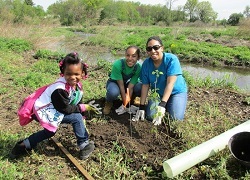Environmental Justice Newsletter
The New York State Department of Environmental Conservation sent this bulletin on 02/09/2021 12:29 PM EST |
| DEC Delivers - Information to keep you connected and informed from the NYS Department of Environmental Conservation |
| Share or view as a web page || Update preferences or unsubscribe |
Environmental Justice Newsletter |
Order Your Seedlings Today!
New York schools and youth organizations can apply to receive 30-50 free tree or shrub seedlings to plant with their students, offering young people an up-close opportunity to participate in conservation while learning about trees and their ecosystem functions. Each school or organization may receive one order per year. Apply online now through March 31st. If you need assistance, contact the Saratoga Tree Nursery at 518.581.1439. Looking for some tree planting inspiration? Arbor Day is just around the corner on April 30, and a socially-distanced planting event is a great way to celebrate the many benefits trees provide. EPA's New Speaker's SeriesThe U.S. Environmental Protection Agency is launching the Environmental Justice (EJ) and Systemic Racism Speaker Series by featuring The Mapping Inequality Project on March 4, 2021 from Noon – 1 p.m. EST. This unique collaboration created a foundational resource for unprecedented research, education, organizing, and policy advocacy on redlining and current environmental challenges. The series will begin with a set of five sessions that thoroughly examines the relationship of redlining and current environmental challenges, particularly the climate crisis. It provides publicly accessible digitized versions of redlining maps for about 200 cities. This has already generated an explosion of trailblazing work in the area of EJ and systemic racism. Project co-founders Robert Nelson, University of Richmond, and LaDale Winling, Virginia Tech, will discuss the genesis, philosophy, methodology, and impact of this game changing project. What is Climate Migration?Climate migrants are people who are forced to flee their home regions because of sudden or gradual environmental changes due to the impacts of climate change. These environmental impacts, such as drought, flooding, and increases in extreme weather events, compromise their safety, livelihoods and health. Although many climate migrants reside in rural parts of South America, the coastal areas of the Pacific Islands, and drought ravaged Sub-Saharan Africa, environmental stressors like sea level rise and extreme weather events have forced some New Yorkers from their homes. This is commonly the case in vulnerable environmental justice communities in rural and urban zones of our state. Following Hurricane Maria, New York State dedicated approximately $13 million to support the more than 11,000 displaced victims from Puerto Rico living in the state. Additionally, Governor Cuomo committed up to $11 million in housing and workforce funding for those displaced by the storm. Unfortunately, estimates on the number of climate migrants are inadequate. This is part of a larger issue of climate migration; it is very difficult to track. People move from place to place for a multitude of reasons. While proximity to environmental stressors or extreme weather events might factor largely into one’s decision to vacate an area, there may be economic or social reasons at play. Additionally, movements within a location, e.g., NYC to upstate or rural to urban, are usually not documented. Essentially, if you’re not specifically looking for this data, a direct causal link between migration and environmental stressors may be impossible to track. In New York, a focus on the effects environmental stressors have on migration will be critical in creating a clear plan to tackle the issue as well as continued dedication to mitigating and reducing the effects of climate change through legislation and programs that support adaptation and resilience planning on a local government level. Additional information of climate migration:
|

 Looking to meet Next Generation Science Standards in creative and engaging ways? Whether you’re a teacher or a club leader,
Looking to meet Next Generation Science Standards in creative and engaging ways? Whether you’re a teacher or a club leader,